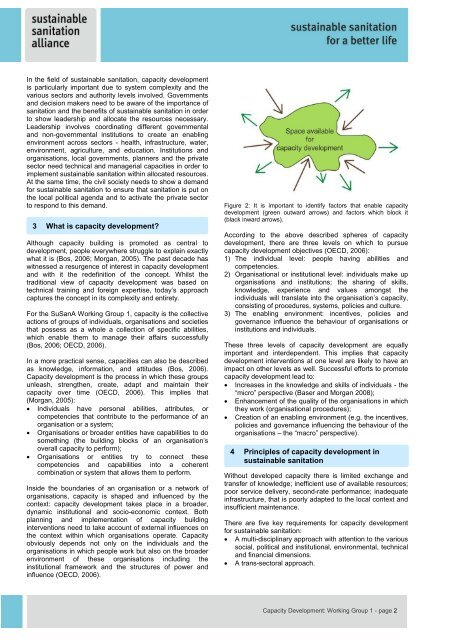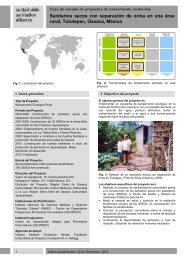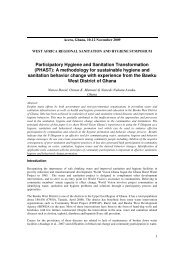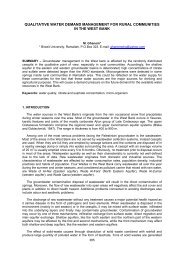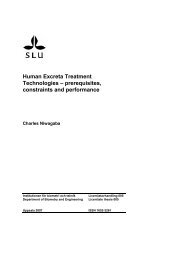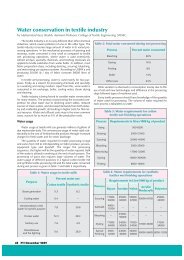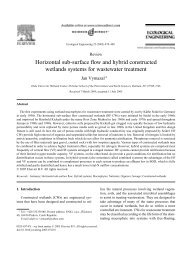Compilation of 13 factsheets on key sustainable sanitation ... - SSWM
Compilation of 13 factsheets on key sustainable sanitation ... - SSWM
Compilation of 13 factsheets on key sustainable sanitation ... - SSWM
Create successful ePaper yourself
Turn your PDF publications into a flip-book with our unique Google optimized e-Paper software.
In the field <str<strong>on</strong>g>of</str<strong>on</strong>g> <strong>sustainable</strong> sanitati<strong>on</strong>, capacity development<br />
is particularly important due to system complexity and the<br />
various sectors and authority levels involved. Governments<br />
and decisi<strong>on</strong> makers need to be aware <str<strong>on</strong>g>of</str<strong>on</strong>g> the importance <str<strong>on</strong>g>of</str<strong>on</strong>g><br />
sanitati<strong>on</strong> and the benefits <str<strong>on</strong>g>of</str<strong>on</strong>g> <strong>sustainable</strong> sanitati<strong>on</strong> in order<br />
to show leadership and allocate the resources necessary.<br />
Leadership involves coordinating different governmental<br />
and n<strong>on</strong>-governmental instituti<strong>on</strong>s to create an enabling<br />
envir<strong>on</strong>ment across sectors - health, infrastructure, water,<br />
envir<strong>on</strong>ment, agriculture, and educati<strong>on</strong>. Instituti<strong>on</strong>s and<br />
organisati<strong>on</strong>s, local governments, planners and the private<br />
sector need technical and managerial capacities in order to<br />
implement <strong>sustainable</strong> sanitati<strong>on</strong> within allocated resources.<br />
At the same time, the civil society needs to show a demand<br />
for <strong>sustainable</strong> sanitati<strong>on</strong> to ensure that sanitati<strong>on</strong> is put <strong>on</strong><br />
the local political agenda and to activate the private sector<br />
to resp<strong>on</strong>d to this demand.<br />
3 What is capacity development?<br />
Although capacity building is promoted as central to<br />
development, people everywhere struggle to explain exactly<br />
what it is (Bos, 2006; Morgan, 2005). The past decade has<br />
witnessed a resurgence <str<strong>on</strong>g>of</str<strong>on</strong>g> interest in capacity development<br />
and with it the redefiniti<strong>on</strong> <str<strong>on</strong>g>of</str<strong>on</strong>g> the c<strong>on</strong>cept. Whilst the<br />
traditi<strong>on</strong>al view <str<strong>on</strong>g>of</str<strong>on</strong>g> capacity development was based <strong>on</strong><br />
technical training and foreign expertise, today’s approach<br />
captures the c<strong>on</strong>cept in its complexity and entirety.<br />
For the SuSanA Working Group 1, capacity is the collective<br />
acti<strong>on</strong>s <str<strong>on</strong>g>of</str<strong>on</strong>g> groups <str<strong>on</strong>g>of</str<strong>on</strong>g> individuals, organisati<strong>on</strong>s and societies<br />
that possess as a whole a collecti<strong>on</strong> <str<strong>on</strong>g>of</str<strong>on</strong>g> specific abilities,<br />
which enable them to manage their affairs successfully<br />
(Bos, 2006; OECD, 2006).<br />
In a more practical sense, capacities can also be described<br />
as knowledge, informati<strong>on</strong>, and attitudes (Bos, 2006).<br />
Capacity development is the process in which these groups<br />
unleash, strengthen, create, adapt and maintain their<br />
capacity over time (OECD, 2006). This implies that<br />
(Morgan, 2005):<br />
• Individuals have pers<strong>on</strong>al abilities, attributes, or<br />
competencies that c<strong>on</strong>tribute to the performance <str<strong>on</strong>g>of</str<strong>on</strong>g> an<br />
organisati<strong>on</strong> or a system;<br />
• Organisati<strong>on</strong>s or broader entities have capabilities to do<br />
something (the building blocks <str<strong>on</strong>g>of</str<strong>on</strong>g> an organisati<strong>on</strong>’s<br />
overall capacity to perform);<br />
• Organisati<strong>on</strong>s or entities try to c<strong>on</strong>nect these<br />
competencies and capabilities into a coherent<br />
combinati<strong>on</strong> or system that allows them to perform.<br />
Inside the boundaries <str<strong>on</strong>g>of</str<strong>on</strong>g> an organisati<strong>on</strong> or a network <str<strong>on</strong>g>of</str<strong>on</strong>g><br />
organisati<strong>on</strong>s, capacity is shaped and influenced by the<br />
c<strong>on</strong>text: capacity development takes place in a broader,<br />
dynamic instituti<strong>on</strong>al and socio-ec<strong>on</strong>omic c<strong>on</strong>text. Both<br />
planning and implementati<strong>on</strong> <str<strong>on</strong>g>of</str<strong>on</strong>g> capacity building<br />
interventi<strong>on</strong>s need to take account <str<strong>on</strong>g>of</str<strong>on</strong>g> external influences <strong>on</strong><br />
the c<strong>on</strong>text within which organisati<strong>on</strong>s operate. Capacity<br />
obviously depends not <strong>on</strong>ly <strong>on</strong> the individuals and the<br />
organisati<strong>on</strong>s in which people work but also <strong>on</strong> the broader<br />
envir<strong>on</strong>ment <str<strong>on</strong>g>of</str<strong>on</strong>g> these organisati<strong>on</strong>s including the<br />
instituti<strong>on</strong>al framework and the structures <str<strong>on</strong>g>of</str<strong>on</strong>g> power and<br />
influence (OECD, 2006).<br />
Figure 2: It is important to identify factors that enable capacity<br />
development (green outward arrows) and factors which block it<br />
(black inward arrows).<br />
According to the above described spheres <str<strong>on</strong>g>of</str<strong>on</strong>g> capacity<br />
development, there are three levels <strong>on</strong> which to pursue<br />
capacity development objectives (OECD, 2006):<br />
1) The individual level: people having abilities and<br />
competencies.<br />
2) Organisati<strong>on</strong>al or instituti<strong>on</strong>al level: individuals make up<br />
organisati<strong>on</strong>s and instituti<strong>on</strong>s; the sharing <str<strong>on</strong>g>of</str<strong>on</strong>g> skills,<br />
knowledge, experience and values am<strong>on</strong>gst the<br />
individuals will translate into the organisati<strong>on</strong>’s capacity,<br />
c<strong>on</strong>sisting <str<strong>on</strong>g>of</str<strong>on</strong>g> procedures, systems, policies and culture.<br />
3) The enabling envir<strong>on</strong>ment: incentives, policies and<br />
governance influence the behaviour <str<strong>on</strong>g>of</str<strong>on</strong>g> organisati<strong>on</strong>s or<br />
instituti<strong>on</strong>s and individuals.<br />
These three levels <str<strong>on</strong>g>of</str<strong>on</strong>g> capacity development are equally<br />
important and interdependent. This implies that capacity<br />
development interventi<strong>on</strong>s at <strong>on</strong>e level are likely to have an<br />
impact <strong>on</strong> other levels as well. Successful efforts to promote<br />
capacity development lead to:<br />
• Increases in the knowledge and skills <str<strong>on</strong>g>of</str<strong>on</strong>g> individuals - the<br />
“micro” perspective (Baser and Morgan 2008);<br />
• Enhancement <str<strong>on</strong>g>of</str<strong>on</strong>g> the quality <str<strong>on</strong>g>of</str<strong>on</strong>g> the organisati<strong>on</strong>s in which<br />
they work (organisati<strong>on</strong>al procedures);<br />
• Creati<strong>on</strong> <str<strong>on</strong>g>of</str<strong>on</strong>g> an enabling envir<strong>on</strong>ment (e.g. the incentives,<br />
policies and governance influencing the behaviour <str<strong>on</strong>g>of</str<strong>on</strong>g> the<br />
organisati<strong>on</strong>s – the “macro” perspective).<br />
4 Principles <str<strong>on</strong>g>of</str<strong>on</strong>g> capacity development in<br />
<strong>sustainable</strong> sanitati<strong>on</strong><br />
Without developed capacity there is limited exchange and<br />
transfer <str<strong>on</strong>g>of</str<strong>on</strong>g> knowledge; inefficient use <str<strong>on</strong>g>of</str<strong>on</strong>g> available resources;<br />
poor service delivery, sec<strong>on</strong>d-rate performance; inadequate<br />
infrastructure, that is poorly adapted to the local c<strong>on</strong>text and<br />
insufficient maintenance.<br />
There are five <strong>key</strong> requirements for capacity development<br />
for <strong>sustainable</strong> sanitati<strong>on</strong>:<br />
• A multi-disciplinary approach with attenti<strong>on</strong> to the various<br />
social, political and instituti<strong>on</strong>al, envir<strong>on</strong>mental, technical<br />
and financial dimensi<strong>on</strong>s.<br />
• A trans-sectoral approach.<br />
Capacity Development: Working Group 1 - page 2


